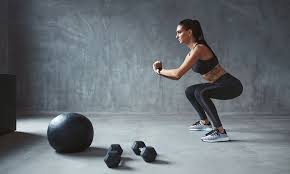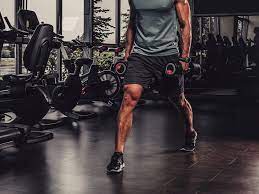
5 Ultimate Leg Exercises at Home for Fast Results!
Introduction
Leg exercises at home are practical, accessible, and require minimal equipment, making them ideal for all fitness levels. They leverage body weight for resistance, promoting strength and endurance. At-home exercises are also time-efficient, allowing you to integrate them into a busy schedule without needing a gym.
Benefits of Strong Legs for Overall Fitness
Strong legs form the foundation for overall fitness by improving mobility, balance, and stability. Leg muscles support daily activities like walking, climbing stairs, and lifting. Additionally, strengthening your legs enhances metabolic rate due to the large muscle groups involved, contributing to better calorie burn and cardiovascular health.
Bodyweight Squats: The Foundation of Leg Exercises
Why Bodyweight Squats Work
Bodyweight squats target multiple muscle groups simultaneously, including the quadriceps, hamstrings, glutes, and calves. This compound movement mimics natural motion patterns, improving functional strength and posture. Squats also engage your core, contributing to overall stability.
How to Perform Bodyweight Squats Correctly
1. Stand with feet shoulder-width apart, toes slightly pointing outward.
2. Keep your chest up and gaze forward.
3. Lower your body by bending your knees and pushing your hips back like sitting in a chair.
4. Go as low as your flexibility allows, ideally until thighs are parallel to the floor.
5. Return to the starting position by driving through your heels.
Pro Tips for Maximizing Results
– Engage your core throughout the movement to avoid arching your back.
– Keep your knees aligned with your toes to prevent strain.
– Perform slow, controlled movements for better muscle engagement.
– Add a pause at the bottom for increased difficulty.

Lunges: A Dynamic Leg Exercise for Balance and Strength
Benefits of Lunges for Leg Muscles
Lunges are excellent for improving balance, coordination, and unilateral strength by working each leg independently. They target the quadriceps, hamstrings, and glutes while engaging the stabilizing muscles in your core and hips.
Step-by-Step Guide to Perfect Lunges
1. Start by standing upright with your feet hip-width apart.
2. Step forward with one foot and lower your body until both knees form 90-degree angles.
3. Ensure your front knee stays above your ankle and doesn’t extend past your toes.
4. Push through your front heel to return to the starting position.
Variations to Challenge Yourself
– Reverse Lunges: Step backward instead of forward for added stability and reduced knee strain.
– Walking Lunges: Step forward alternately, adding a dynamic element to the exercise.
– Jumping Lunges: Explosively switch legs mid-air for a high-intensity variation.
Glute Bridges: A Leg Exercise for Hamstrings and Glutes
What Makes Glute Bridges Effective
Glute bridges primarily target the glutes and hamstrings while strengthening the lower back and improving hip mobility. This low-impact exercise is suitable for all fitness levels, making it great for injury prevention and rehabilitation.
Proper Form to Avoid Injury
1. Lie on your back with your knees bent and feet flat on the floor, hip-width apart.
2. Keep your arms by your sides, palms facing down.
3. Press through your heels to lift your hips towards the ceiling, forming a straight line from shoulders to knees.
4. Lower your hips back down without touching the floor.
Ways to Intensify Glute Bridges
– Single-Leg Glute Bridge: Perform the movement with one leg lifted.
– Add Resistance Resistance: Place a resistance band around your thighs or a weight on your pelvis.
– Pulse at the Top: Add small, controlled pulses at the movement’s peak.
Step-Ups: A Functional Leg Exercise You Can Do Anywhere
Advantages of Step-Ups for Leg Strength
Step-ups mimic real-life movements like climbing stairs, improving functional strength, stability, and balance. They target the quadriceps, hamstrings, and glutes while engaging the core for stabilization.
How to Perform Step-Ups at Home
1. Find a sturdy surface like a step, box, or low bench.
2. Step up with one foot, ensuring the whole foot is on the surface.
3. Push through your front heel to lift your body and bring the trailing leg up.
4. Step back down and repeat on the other leg.
Alternatives if You Don’t Have a Step
– Perform static lunges or Bulgarian split squats using a chair for similar benefits.
– Use staircases for step-ups if a workout bench isn’t available.

5. Calf Raises A Simple Yet Powerful Leg Exercise
Why Calf Raises Are Often Overlooked
Calf raises focus on the often-neglected calf muscles, essential for lower-leg strength, ankle stability, and explosive movements like running and jumping. Despite their importance, they are frequently overlooked in workout routines.
Correct Technique for Maximum Impact
1. Stand with your feet hip-width apart.
2. Slowly lift your heels, rising onto your toes.
3. Hold the top position briefly to maximize contraction.
4. Lower your heels back to the starting position.
How to Incorporate Weights for More Intensity
– Hold dumbbells or a weighted object in your hands.
– Perform the exercise on one leg for increased difficulty.
– Use a step to allow a more excellent range of motion, dropping your heels below the level of the step.
Bonus Tips for Fast Results
Creating a Consistent Home Leg Exercise Routine
Consistency is the key to achieving fast and sustainable results. A structured leg exercise routine ensures progressive overload and muscle adaptation over time. Here’s how to create an effective routine:
1. Schedule Your Workouts: Commit to 3-4 weekly sessions, dedicating 20-30 minutes to leg exercises.
2. Set Goals: Define specific objectives, such as improving balance, building strength, or toning muscles.
3. Mix It Up: Incorporate various exercises (squats, lunges, glute bridges, step-ups, and calf raises) to target all major leg muscles and prevent plateaus.
4. Track Progress: Record your reps, sets, and any added resistance to ensure continuous improvement.
Importance of Warm-Up and Stretching
Warm-ups and stretching prepare your body for exercise, reduce the risk of injury and enhance performance.
1. Warm-Up: Begin with 5-10 minutes of light cardio, such as jogging in place, jumping jacks, or dynamic leg swings, to increase blood flow and loosen up muscles.
2. Dynamic Stretching: Incorporate movements like leg swings, lunges with a twist, or high knees to enhance the range of motion and activate key muscles.
3. Post-Workout Stretching: After your workout, use static stretches to relax muscles and improve flexibility. Hold stretches like hamstring or butterfly poses for 20-30 seconds.
Incorporating Rest Days for Recovery
Rest is as crucial as the workout itself for muscle repair and growth. Overtraining can lead to fatigue and hinder progress. Here’s how to optimize recovery:
1. Plan Rest Days: Schedule at least one or two rest days per week to allow muscles to rebuild stronger.
2. Active Recovery: Engage in low-intensity activities like walking, yoga, or light stretching to promote blood circulation and reduce stiffness.
3. Prioritize Sleep and Nutrition: Adequate sleep and a balanced diet rich in protein, healthy fats, and carbohydrates support muscle repair and energy replenishment.
Conclusion
– Bodyweight Squats: Build foundational strength and tone multiple leg muscles.
– Lunges: Improve balance, coordination, and unilateral strength.
– Glute Bridges: Target glutes and hamstrings while enhancing hip mobility.
– Step-Ups: Boost functional strength and mimic real-life movements.
– Calf Raises: Strengthen calves for better ankle stability and explosive power.
Sticking to your leg exercise routine and incorporating these bonus tips will yield visible results. Remember, progress is gradual, but dedication pays off. Celebrate small milestones, listen to your body, and keep pushing forward. Strong legs are not just a fitness goal but a foundation for a healthier, more active lifestyle. You’ve got this! 💪

FAQs
How often should I do leg exercises at home?
Aim for 3–4 times a week, with at least one rest day in between.
Can I build muscle without weights at home ?
Yes! Bodyweight exercises like squats and lunges can effectively build muscle when done with proper form and increased intensity.
What if I don’t have any equipment?
Use household items like sturdy chairs for step-ups or water bottles for added resistance.
How long does it take to see results?
With consistency, you can start noticing changes in strength and tone within 4–6 weeks.
What’s the best time of day for leg exercises?
The best time is when you feel most energetic. For most, this is in the morning or early evening.
How do I avoid knee pain during leg exercises?
Focus on proper form, engage your core, and avoid overextending your knees.
Can beginners do these leg exercises?
Absolutely! Start with fewer reps and gradually increase as you get stronger
Do I need to stretch before leg exercises?
Yes, dynamic stretches like leg swings or light jogging can help prevent injuries.
How can I make these exercises more challenging?
Add resistance bands, hold weights, or increase your repetitions and sets.
For more details [visit here]
Video [visit here]







